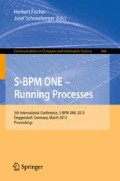Abstract
The number of researches in the field of practical business process modeling (BPM) as well as process model (PM) quality and its influencing factors is very low. In this paper we address two aspects in that regard. We investigate the use of semiformal modeling languages in companies. To that end, we performed a pen and paper experiment involving 43 participants in 2011. Thereof, we derived four process design archetypes. The results reveal that formal BPM has still not been accepted as a useful practice in firms - mainly flowcharts are used for process design. We seize this circumstance in the second part of this work focussing on the comprehensibility of BPM languages. Based on the survey data of 77 employees obtained in 2012, we analyzed to what extent different PMs are understood by individuals. We found that the comic representation storyboard design is intuitive and easily understood. BPMN and UML also achieved good results, albeit subject to certain restrictions. Participants had problems with EPC and across all notations with concurrent activities. We therefore recommend the use of storyboards in field BPM as well as further accompanying investigations.
Access this chapter
Tax calculation will be finalised at checkout
Purchases are for personal use only
Preview
Unable to display preview. Download preview PDF.
References
Recker, J., Safrudin, N., Rosemann, M.: How Novices Model Business Processes. In: Hull, R., Mendling, J., Tai, S. (eds.) BPM 2010. LNCS, vol. 6336, pp. 29–44. Springer, Heidelberg (2010)
Grosskopf, A., Edelman, J., Weske, M.: Tangible Business Process Modeling – Methodology and Experiment Design. In: Rinderle-Ma, S., Sadiq, S., Leymann, F. (eds.) BPM 2009. LNBIP, vol. 43, pp. 489–500. Springer, Heidelberg (2010)
Eikebrokk, T.R., Iden, J., Olsen, D.H., Opdahl, A.L.: Understanding the determinants of business process modelling in organisations. Business Process Management Journal 17, 639–662 (2011)
Rosemann, M.: Potential pitfalls of process modeling: part A. Business Process Management Journal 12, 249–254 (2006)
Rittgen, P.: Collaborative modeling of business processes: a comparative case study. In: Proceedings of the 2009 ACM Symposium on Applied Computing (SAC 2009), pp. 225–230. ACM, New York (2009)
Mendling, J., Reijers, H.A., Cardoso, J.: What Makes Process Models Understandable? In: Alonso, G., Dadam, P., Rosemann, M. (eds.) BPM 2007. LNCS, vol. 4714, pp. 48–63. Springer, Heidelberg (2007)
Moody, D.L.: Theoretical and practical issues in evaluating the quality of conceptual models: current state and future directions. Data Knowl. Eng. 55, 243–276 (2005)
Pohl, K., Rupp, C.: Basiswissen Requirements Engineering: Aus- und Weiterbildung zum Certified Professional for Requirements Engineering; Foundation-Level nach IREB-Standard. Dpunkt.verlag, Heidelberg (2009)
Hiller, C., Minar-Hoedel, P., Zahradnik, H.: Prozessmanagement: Komplexe Prozesse einfach steuern. Goldegg, Vienna (2010)
Allweyer, T.: Geschaeftsprozessmanagement: Strategie, Entwurf, Implementierung, Controlling. W3L, Herdecke (2005)
Rosemann, M.: Stichwort Prozessmodell. In: Mertens, P., et al. (eds.) Lexikon der Wirtschaftsinformatik, p. 334. Springer, Berlin (1997)
Hogrebe, F., Pagel, S., Juergens, A., Nuettgens, M.: EPK-Varianten auf dem Pruefstand: Explorative Studie zur Gebrauchstauglichkeit von eEPK und oEPK. In: Nuettgens, M., Rump, F.J., Mendling, J., Gehrke, N. (eds.) EPK 2009, Berlin. Geschaeftsprozessmanagement mit Ereignisgesteuerten Prozessketten. 8. Workshop der Gesellschaft fuer Informatik e.V (GI) und Treffen ihres Arbeitskreises “Geschaeftsprozessmanagement mit Ereignisgesteuerten Prozessketten (WI-EPK)”, pp. 195–212 (2009)
Isselhorst, T.: Modellierung von Kontextontologien zur Informationsbedarfsermittlung in der Unternehmensfuehrung. In: Lehner, F., Noesekabel, H., Kleinschmidt, P. (eds.) Multikonferenz Wirtschaftsinformatik Band, vol. 2, pp. 83–96. GITO, Berlin (2006)
Recker, J.C., Dreiling, A.: Does it matter which process modelling language we teach or use? An experimental study on understanding process modelling languages without formal education. In: Toleman, M., Cater-Steel, A., Roberts, D. (eds.) 18th Australasian Conference on Information Systems, Toowoomba (2007)
Eppler, M.J., Burkhard, R.A.: Knowledge visualization. In: Schwartz, D. (ed.) Encycolpedia of Knowledge Management, pp. 551–560. Idea Group Inc., London (2006)
Rogers, Y.: Pictorial representations of abstract concepts relating to human-computer interaction. SIGCHI Bull. 18, 43–44 (1986)
Mendling, J., Reijers, H.A., Recker, J.: Activity labeling in process modeling: Empirical insights and recommendations. Inf. Syst. 35, 467–482 (2010)
Moody, D.L.: The physics of notions: towards a scientific basis for constructing visual notions in software engineering. IEEE Transactions on Software Engineering 35, 759–782 (2009)
Guenther, A., Schuepferling, D., Pikalek, C.: Dokumentation von Anforderungen - gut dokumentiert ist halb gebaut. In: Rupp, C. (ed.) Requirements-Engineering und -Management, pp. 183–245. Hanser, Munich (2009)
Versteegen, G.: Konfigurations management. Springer, Berlin (2003)
Mendling, J., Neumann, G., van der Aalst, W.M.P.: Understanding the Occurrence of Errors in Process Models Based on Metrics. In: Meersman, R., Tari, Z. (eds.) OTM 2007, Part I. LNCS, vol. 4803, pp. 113–130. Springer, Heidelberg (2007)
Keller, C., Kuehn, R., Schlegel, T.: Vorgehensmodell zum Einsatz von Storyboarding als Basistechnik fuer die kontext- und modellbasierte Ableitung von Interaction-Cases fuer ubiquitaere Systeme. Informatik 2011: Informatik schafft Communities, P- 192, 297 (2011)
Stickdorn, M., Schneider, J.: This is service design thinking. BIS Publishers, Amsterdam (2010)
Diekmann, A.: Empirische Sozialforschung: Grundlagen, Methoden, Anwendungen. Rowohlt, Reinbek bei Hamburg (2005)
Author information
Authors and Affiliations
Editor information
Editors and Affiliations
Rights and permissions
Copyright information
© 2013 Springer-Verlag Berlin Heidelberg
About this paper
Cite this paper
Weitlaner, D., Guettinger, A., Kohlbacher, M. (2013). Intuitive Comprehensibility of Process Models. In: Fischer, H., Schneeberger, J. (eds) S-BPM ONE - Running Processes. S-BPM ONE 2013. Communications in Computer and Information Science, vol 360. Springer, Berlin, Heidelberg. https://doi.org/10.1007/978-3-642-36754-0_4
Download citation
DOI: https://doi.org/10.1007/978-3-642-36754-0_4
Publisher Name: Springer, Berlin, Heidelberg
Print ISBN: 978-3-642-36753-3
Online ISBN: 978-3-642-36754-0
eBook Packages: Computer ScienceComputer Science (R0)

